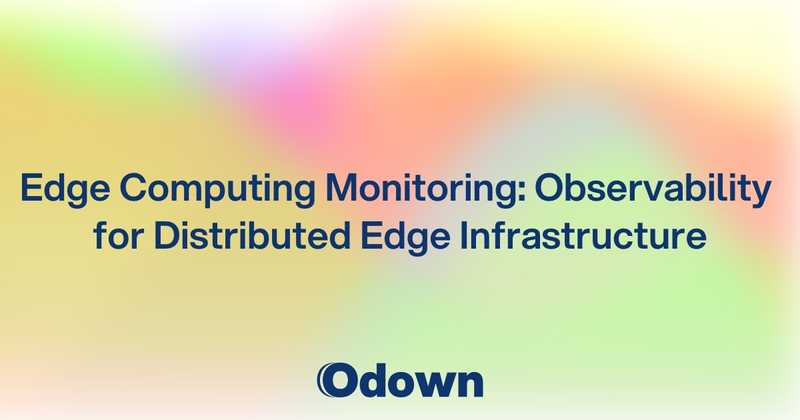Edge Computing Monitoring: Observability for Distributed Edge Infrastructure
Your autonomous vehicle's edge computing system just lost connectivity while navigating a busy intersection. Your smart factory's edge devices are operating normally, but data synchronization with the cloud failed three hours ago. Your mobile app users are experiencing terrible performance because edge caches aren't updating properly. These aren't traditional monitoring problems---they're edge computing challenges that require entirely new approaches to observability.
Edge computing pushes processing power closer to where data is generated and consumed, reducing latency and improving user experience. But this distributed architecture creates monitoring blind spots that traditional cloud-based monitoring tools can't address effectively.
The edge presents unique monitoring challenges: intermittent connectivity, resource constraints, geographic distribution, and the need for autonomous operation when disconnected from central management systems. Your monitoring strategy must work whether edge devices have perfect connectivity or are completely isolated.
Modern monitoring platforms adapt to edge computing requirements by providing distributed monitoring capabilities that work across hybrid cloud-edge architectures. But effective edge monitoring requires understanding the constraints and opportunities that edge computing creates.
Edge Computing Challenges: Latency, Connectivity, and Resource Constraints
Edge computing environments operate under constraints that don't exist in traditional data center or cloud environments, requiring monitoring approaches that work within these limitations.
Latency Requirements and Real-Time Processing
Edge computing exists specifically to reduce latency, making monitoring systems that add delay unacceptable:
Ultra-low latency applications like autonomous vehicles or industrial control systems can't tolerate monitoring overhead that interferes with real-time processing. Monitoring systems must be lightweight and efficient to avoid impacting critical operations.
Local decision-making requirements mean edge systems must operate autonomously when connectivity to central monitoring systems is unreliable. Edge monitoring must provide local alerting and response capabilities.
Time-sensitive data processing at the edge requires monitoring that can keep up with high-frequency operations. Traditional monitoring approaches that sample data periodically might miss critical events in fast-moving edge environments.
Connectivity Challenges and Intermittent Networks
Edge devices often operate in environments with unreliable network connectivity that affects monitoring strategies:
Intermittent connectivity requires monitoring systems that can operate during network outages and synchronize data when connections are restored. Edge monitoring must buffer data locally and handle graceful degradation.
Bandwidth limitations in many edge environments mean monitoring data transmission must be optimized to avoid consuming bandwidth needed for business operations. Monitoring systems need intelligent data compression and prioritization.
Network latency variability affects the reliability of cloud-based monitoring dashboards. Edge monitoring systems need local visibility capabilities that don't depend on real-time connectivity to central systems.
Resource Constraints and Power Management
Edge devices typically have limited computational resources and power budgets that affect monitoring implementation:
CPU and memory limitations mean monitoring systems must be extremely efficient and lightweight. Traditional monitoring agents designed for servers might be too resource-intensive for edge devices.
Power consumption considerations are critical for battery-powered edge devices. Monitoring systems must minimize energy usage while providing necessary visibility into device operation.
Storage constraints limit the amount of monitoring data that can be stored locally. Edge monitoring requires intelligent data retention and compression strategies to maximize value within storage limitations.
Edge Device Monitoring: IoT Sensors, Gateways, and Computing Nodes
Different types of edge devices require different monitoring approaches based on their capabilities, roles, and constraints.
IoT Sensor Monitoring Strategies
IoT sensors represent the most resource-constrained edge devices and require specialized monitoring approaches:
Battery life monitoring is critical for wireless sensors that can't be easily accessed for maintenance. Monitoring systems must track power consumption patterns and predict when batteries need replacement.
Sensor accuracy validation ensures that IoT sensors continue providing reliable data over time. Environmental factors, calibration drift, and hardware degradation can affect sensor accuracy in ways that traditional monitoring might miss.
Communication reliability tracking monitors how effectively sensors transmit data to gateways or cloud systems. Packet loss, transmission delays, and communication failures need local detection and remediation.
Gateway Device Observability
Edge gateways serve as aggregation points and often have more resources available for monitoring:
Data aggregation monitoring tracks how effectively gateways collect and process data from multiple sensors. Gateway overload or processing failures can affect entire sensor networks.
Protocol translation monitoring ensures that gateways correctly convert between different communication protocols. Protocol conversion errors can cause data corruption or loss that affects downstream processing.
Security gateway monitoring tracks authentication, encryption, and access control functions. Edge gateways often serve as security boundaries that need specialized monitoring.
Computing Node Performance
Edge computing nodes have significant processing capabilities but still operate under constraints:
Workload distribution monitoring tracks how efficiently edge nodes handle distributed computing tasks. Load balancing and task allocation affect both performance and reliability.
Container orchestration monitoring manages containerized applications running on edge infrastructure. Edge-specific orchestration challenges require specialized monitoring approaches.
Storage and caching performance at edge nodes affects application response times and user experience. Local storage optimization and cache hit rates need continuous monitoring.
Edge-to-Cloud Monitoring: Hybrid Architecture Observability
Most edge computing implementations use hybrid architectures that combine edge processing with cloud-based management and analytics, requiring monitoring strategies that span both environments.
Hybrid Data Flow Monitoring
Data flows between edge and cloud in complex patterns that require specialized monitoring:
Bi-directional synchronization monitoring tracks data movement in both directions between edge and cloud systems. Synchronization failures can cause data inconsistencies that affect application behavior.
Data pipeline monitoring covers the entire journey from edge data collection through cloud processing and analytics. End-to-end visibility helps identify bottlenecks and optimization opportunities.
Conflict resolution monitoring tracks how systems handle data conflicts when edge and cloud systems have different versions of the same information. Conflict resolution failures can cause data corruption or application errors.
Federated Monitoring Architecture
Hybrid edge-cloud environments require monitoring architectures that work across different infrastructure types:
Local monitoring autonomy ensures that edge locations can monitor themselves even when disconnected from central systems. Local monitoring capabilities prevent complete visibility loss during connectivity issues.
Centralized correlation and analysis aggregate monitoring data from multiple edge locations to identify patterns and trends that aren't visible from individual locations. Cloud-based analytics provide insights that aren't possible with edge-only monitoring.
Policy distribution and management ensure that monitoring configurations remain consistent across edge locations while allowing for local customization based on specific requirements.
Performance Optimization Across Edge-Cloud
Hybrid architectures require optimization strategies that consider both edge and cloud components:
Workload placement optimization determines which processing should happen at the edge versus in the cloud. Monitoring data helps optimize these placement decisions based on actual performance and cost data.
Caching strategy optimization improves performance by intelligently caching data at appropriate points in the edge-cloud architecture. Cache hit rates and performance metrics guide optimization decisions.
Network resource optimization minimizes bandwidth usage while maintaining application performance. Monitoring data helps identify opportunities to reduce network traffic through better data processing and caching strategies.
5G Network Monitoring: Ultra-Low Latency and High-Bandwidth Applications
5G networks enable new classes of edge computing applications with ultra-low latency requirements that demand specialized monitoring approaches.
5G Network Performance Characteristics
5G networks have unique performance characteristics that affect monitoring strategies:
Ultra-low latency monitoring requires measurement techniques that can detect latency variations measured in milliseconds. Traditional monitoring approaches might not have sufficient resolution for 5G applications.
Massive bandwidth monitoring tracks utilization of 5G's high-bandwidth capabilities. Network congestion and bandwidth allocation affect application performance in ways that require specialized monitoring.
Network slicing monitoring ensures that different application types receive appropriate network resources. 5G network slicing allows different applications to have different performance characteristics that need independent monitoring.
Edge Mobile Application Monitoring
5G enables mobile applications with edge computing capabilities that require new monitoring approaches:
Mobility-aware monitoring tracks application performance as users move between different edge locations and network cells. Handoff performance and roaming behavior affect user experience.
Location-based performance monitoring correlates application performance with geographic location and network topology. Performance variations based on location help optimize edge deployment strategies.
Device-specific monitoring accounts for the wide variety of 5G-capable devices with different performance characteristics. Application performance varies significantly across different device types and capabilities.
Real-Time Application Monitoring
5G enables real-time applications that require specialized monitoring techniques:
Latency jitter monitoring tracks variations in network latency that can affect real-time applications. Consistent low latency is often more important than average latency for real-time use cases.
Quality of service monitoring ensures that applications receive appropriate network resources based on their requirements. QoS violations can severely impact user experience for latency-sensitive applications.
Predictive performance monitoring uses machine learning to predict network performance issues before they affect applications. Proactive monitoring enables preventive actions that maintain application performance.
Edge computing monitoring requires integration with traditional infrastructure monitoring to provide complete visibility. AI-powered monitoring and predictive analytics become especially valuable in edge environments where autonomous operation is critical.
Ready to implement comprehensive edge computing monitoring? Use Odown and gain the distributed monitoring capabilities you need to maintain visibility and control across your edge infrastructure while ensuring optimal performance for ultra-low latency applications.



